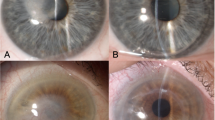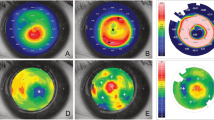Abstract
Background
To evaluate the safety and efficacy of corneal allogenic intrastromal ring segments in the management of keratoconus patients.
Methods
The retrospective, nonrandomized, interventional case series consisted of 65 keratoconic eyes of 49 consecutive patients who had ring segment-shaped corneal allografts (KeraNatural®) implanted in intrastromal tunnels created using a femtosecond laser. The main outcome measures were uncorrected visual acuity (UCVA), corrected distant visual acuity (CDVA), refraction, keratometry, and pachymetry. Computed tomography scans of the corneal surfaces were also performed preoperatively as well as 3, 6 and 12 months postoperatively.
Results
Mean age was 29.5 ± 7.3 years (median 29, range: 20–52 years). The mean UCVA improved from 0.91 ± 0.50 logMAR preoperatively to 0.40 ± 0.24 logMAR postoperatively at 6 month follow-up (p < 0.01) and the mean CDVA improved from 0.87 ± 0.20 logMAR preoperatively to 0.27 ± 0.06 logMAR postoperatively (p < 0.01). The mean spherical equivalent improved from −8.82 ± 4.57 to −3.45 ± 4.81D (p < 0.01). Average Keratometry decreased from 49.23 ± 5.22 preoperatively to 45.63 ± 4.89 D postoperatively (p < 0.01). Mean anterior and posterior maximum elevation were also decreased significantly (p < 0.01). In one patient, dislocation of the graft towards the tunnel incision site and dehiscense at the tunnel entrance were observed in the first week of the operation. Yellow-white deposits were observed in the segment tunnels in five cases after 6 months.
Conclusion
This study demonstrated that implantation of corneal allograft ring segments is a viable alternative treatment for keratoconus with safety and good visual results.
This is a preview of subscription content, access via your institution
Access options
Subscribe to this journal
Receive 18 print issues and online access
$259.00 per year
only $14.39 per issue
Buy this article
- Purchase on Springer Link
- Instant access to full article PDF
Prices may be subject to local taxes which are calculated during checkout


Similar content being viewed by others
Data availability
Anonymised data for this study is available from the corresponding author upon reasonable request.
References
Rho CR, Na KS, Yoo YS, Pandey C, Park CW, Joo CK. Changes in anterior and posterior corneal parameters in patients with keratoconus after intrastromal corneal-ring segment implantation. Curr Eye Res. 2013;38:843–50.
Sögütlü E, Piñero DP, Kubalioglu A, Alió JL, Cinar Y. Elevation changes of central posterior corneal surface after intracorneal ring segment implantation in keratoconus. Cornea. 2012;31:387–95.
Amayem AF, Hamdi IM, Hamdi MM. Refractive and visual outcomes of penetrating keratoplasty versus deep anterior lamellar keratoplasty with hydrodissection for treatment of keratoconus. Cornea. 2013;32:e2–e5.
Kanellopoulos AJ, Pe LH, Perry HD, Donnenfeld ED. Modified intracorneal ring segment implantations (INTACS) for the management of moderate to advanced keratoconus: efficacy and complications. Cornea. 2006;25:29–33.
Coskunseven E, Kymionis GD, Tsiklis NS, Atun S, Arslan E, Siganos CS, et al. Complications of intrastromal corneal ring segment implantation using a femtosecond laser for channel creation: a survey of 850 eyes with keratoconus. Acta Ophthalmol. 2011;89:54–7.
D’Oria F, Abdelghany AA, Ledo N, Barraquer RI, Alio JL. Incidence and reasons for intrastromal corneal ring segment explantation. Am J Ophthalmol. 2021;222:351–8.
Kozhaya K, Joe Mehanna C, Jacob S, Saad A, Jabbur NS, Awwad ST. Management of anterior stromal necrosis after polymethylmethacrylate ICRS: explantation versus exchange with corneal allogenic intrastromal ring segments. J Refract Surg. 2022;38:256–63.
Jacob S, Patel SR, Agarwal A, Ramalingam A, Saijimol AI, Raj JM. Corneal allogenic intrastromal ring segments (CAIRS) combined with corneal cross-linking for keratoconus. J Refract Surg. 2018;34:296–303.
Haciagaoglu S, Tanriverdi C, Keskin FFN, Tran KD, Kilic A. Allograft corneal ring segment for keratoconus management: Istanbul nomogram clinical results Eur J Ophthalmol. 2022:11206721221142995. https://doi.org/10.1177/11206721221142995.
Burris TE, Ayer CT, Evensen DA, Davenport JM. Effects of intrastromal corneal ring size and thickness on corneal flattening in human eyes. Refract Corneal Surg. 1991;7:46–50.
Colin J, Cochener B, Savary G, Malet F, Holmes-Higgin D. INTACS inserts for treating keratoconus: one-year results. Ophthalmology. 2001;108:1409–14.
Alió JL, Artola A, Ruiz-Moreno JM, Hassanein A, Galal A, Awadalla MA. Changes in keratoconic corneas after intracorneal ring segment explantation and reimplantation. Ophthalmology. 2004;111:747–51.
Nguyen N, Gelles JD, Greenstein SA, Hersh PS. Incidence and associations of intracorneal ring segment explantation. J Cataract Refract Surg. 2019;45:153–8.
Zare MA, Hashemi H, Salari MR. Intracorneal ring segment implantation for the management of keratoconus: safety and efficacy. J Cataract Refract Surg. 2007;33:1886–91.
Ruckhofer J, Twa MD, Schanzlin DJ. Clinical characteristics of lamellar channel deposits after implantation of intacs. J Cataract Refract Surg 2000;26:1473–9.
Ertan A, Kamburogulo GAU. Comparison of outcomes of 2 chanel sizes for intrastromal ring segment implantation with femtosecond laser in eyes with keratoconus. J Cataract Refract Surg. 2007;33:648–53.
Tomidokoro A, Oshika T, Amano S, Higaki S, Maeda N, Miyata K. Changes in anterior and posterior corneal curvatures in keratoconus. Ophthalmology. 2000;107:1328–32.
Piñero DP, Alió JL, Alesón A, Escaf Vergara M, Miranda M. Corneal volume, pachymetry, and correlation of anterior and posterior corneal shape in subclinical and different stages of clinical keratoconus. J Cataract Refract Surg. 2010;36:814–25.
Schlegel Z, Hoang-Xuan T, Gatinel D. Comparison of and correlation between anterior and posterior corneal elevation maps in normal eyes and keratoconus-suspect eyes. J Cataract Refract Surg. 2008;34:789–95.
Alió J, Salem T, Artola A, Osman A. Intracorneal rings to correct corneal ectasia after laser in situ keratomileusis. J Cataract Refract Surg. 2002;28:1568–74.
Alió JL, Shabayek MH, Belda JI, Correas P, Feijoo ED. Analysis of results related to good and bad outcomes of Intacs implantation for keratoconus correction. J Cataract Refract Surg. 2006;32:756–61.
Colin J, Cochner B, Savary G, Malet F. Correcting keratoconus with intracorneal rings. J Cataract Refract Surg. 2000;26:1117–22.
Lyra JM, Lyra D, Ribeiro G, Torquetti L, Ferrara P, Machado A. Tomographic findings after implantation of ferrara intrastromal corneal ring segments in keratoconus. J Refract Surg. 2017;33:110–5.
Author information
Authors and Affiliations
Contributions
Concept—SAN, ECY, AK; Design—SAN, ECY, FK, CT; Supervision—ST, CT, AK; Funding—SAN,CT,AK; Materials—SAN, FK, CT, AK; Data Collection and/or processing– SAN, FK, CT; Analysis &/or interpretation— SAN, ECY, ST, AK, Literature search– SAN, ECY, ST, AK; Writing—SAN, ECY, AK; Critical review– SAN, ECY, FK, CT, ST, AK.
Corresponding author
Ethics declarations
Competing interests
AK is a consultant of KeraNatural. The remaining authors have no conflicts of interest to disclose.
Informed consent
Informed consent was obtained for the use of patient’s images.
Additional information
Publisher’s note Springer Nature remains neutral with regard to jurisdictional claims in published maps and institutional affiliations.
Rights and permissions
Springer Nature or its licensor (e.g. a society or other partner) holds exclusive rights to this article under a publishing agreement with the author(s) or other rightsholder(s); author self-archiving of the accepted manuscript version of this article is solely governed by the terms of such publishing agreement and applicable law.
About this article
Cite this article
Nacaroglu, S.A., Yesilkaya, E.C., Perk, F.F.N.K. et al. Efficacy and safety of intracorneal allogenic ring segment implantation in keratoconus: 1-year results. Eye 37, 3807–3812 (2023). https://doi.org/10.1038/s41433-023-02618-5
Received:
Revised:
Accepted:
Published:
Issue Date:
DOI: https://doi.org/10.1038/s41433-023-02618-5



